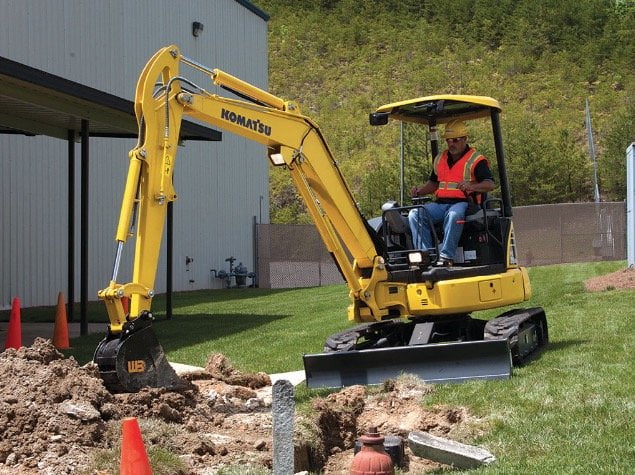معرفی

Excavators are one of the most critical pieces of heavy machinery used in construction, mining, and various other industries. They are designed to dig and move heavy materials, such as soil, rubble, or even large rocks. One of the key factors that determine an excavator’s performance and suitability for a job is its weight. In this comprehensive guide, we will explore the importance of excavator weight, how it affects performance, and what you need to consider when choosing an excavator based on weight.
Understanding Excavator Weight
وزن عملیاتی
This is the total weight of the excavator, including its standard equipment, fuel, and operator. It’s crucial for determining the machine’s stability and the ground pressure it exerts.
Counterweight
The counterweight at the rear of an excavator helps maintain balance, especially when the arm is extended. Its weight directly affects the excavator’s lifting capacity and overall stability.
Transport Weight
This is the weight of the excavator without any attachments or additional counterweights. It’s essential for transportation and regulatory compliance.
The Impact of Excavator Weight on Performance
Stability and Balance
A heavier excavator provides more stability, which is critical when working on uneven terrain or when lifting heavy loads.
Traction
The weight of the excavator, combined with its track system or tires, affects its traction on different surfaces.
Lifting Capacity
The maximum weight an excavator can lift is directly related to its own weight. Heavier excavators generally have a higher lifting capacity.
فشار زمین
Lighter excavators exert less ground pressure, making them suitable for softer or more sensitive ground conditions.
Choosing the Right Excavator Weight for Your Needs

Job Requirements
Consider the size and weight of the materials you need to move. Larger, heavier excavators are needed for more substantial loads.
Terrain
The type of ground you’ll be working on will influence your choice. Heavier excavators are more stable on uneven or steep terrain, while lighter models are better for softer ground.
قابلیت حمل و نقل
Lighter excavators are easier and more cost-effective to transport, which can be a significant factor for businesses with multiple job sites.
Legal Regulations
Different regions have different regulations regarding the transport and operation of heavy machinery. Ensure the excavator’s weight complies with these regulations.
Fuel Efficiency
Heavier excavators consume more fuel, which can impact your operational costs. Consider the fuel efficiency when choosing an excavator.
Comparison of بیل مکانیکی Weight Classes
To help you make an informed decision, we’ve compiled a comparison table of different excavator weight classes, highlighting their typical applications and advantages.
| Weight Class (tons) | Typical Applications | Advantages |
|---|---|---|
| Up to 1 | Light landscaping, digging small ditches | Highly mobile, low ground pressure |
| 1-5 | General construction, site preparation | Versatile, good for varied terrains |
| 5-15 | Heavy construction, mining | High lifting capacity, powerful |
| Over 15 | Large-scale mining, heavy demolition | Most stable, suitable for heavy loads |
نتیجه
Understanding the importance of excavator weight is crucial for selecting the right machine for your job. It affects the excavator’s stability, lifting capacity, and suitability for different terrains. By considering your specific needs, job requirements, and operational costs, you can choose an excavator that offers the perfect balance of weight and performance. As always, safety should be your top priority when operating any heavy machinery.
سوالات متداول
How does the weight of an excavator affect its performance?
The weight of an excavator significantly impacts its performance in various ways. Heavier excavators typically offer more stability and digging power but may have reduced maneuverability and fuel efficiency. Conversely, lighter excavators may excel in tight spaces and consume less fuel but might lack the power needed for heavy-duty tasks.
What are the consequences of operating an excavator beyond its weight capacity?
Operating an excavator beyond its weight capacity can have serious consequences. Overloading can lead to structural damage, increased wear and tear on components, reduced maneuverability, and heightened safety risks for both operators and bystanders. It’s essential to adhere to weight limits specified by manufacturers and regulatory bodies.
How can I determine the weight of an excavator before transporting it to a job site?
Determining the weight of an excavator before transportation is crucial for logistical planning and compliance with weight regulations. Manufacturers typically provide specifications detailing the operating weight of their excavators. Additionally, specialized scales and weighing equipment can be used to accurately measure the weight of the machine and any attachments.
Are there ways to optimize the weight distribution of an excavator for improved performance?
Yes, optimizing the weight distribution of an excavator can enhance its overall performance and safety. Distributing weight evenly across the machine and adjusting attachment configurations can improve stability, reduce soil compaction, and maximize digging efficiency. However, it’s essential to follow manufacturer recommendations and safety guidelines when modifying weight distribution.
How does the weight of an excavator impact its transportation and mobility on job sites?
The weight of an excavator plays a significant role in its transportation and mobility on job sites. Heavier excavators may require specialized trailers and transportation permits, while lighter models offer greater flexibility in terms of access to confined spaces and maneuverability in challenging terrain. Operators must consider weight limitations when planning transportation routes and selecting equipment for specific tasks.







-150x150.webp)
